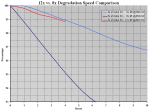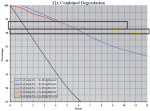Seems like a huge difference in power for low efficiency vs high efficiency...
When I donated for this second 12X diode, I thought we were going to keep it at a lower current for a longer test. But I don't want to be the only one to say 'set it lower'. So go ahead and set it at what ever you think is good for your testing.
Just hate to see it die too soon...
Well, me too, but it's too late now. And believe it or not, i actually feared i was testing too low for other's wishes...
But the thing is, there was something very wrong with this diode from the start.
Not only did it have an absurdly low slope efficiency, all it's characteristics were so unusual, it almost made me think it's an 8x!
But i checked all three sleds and they were 12x sleds. The likellyhood of an 8x diode getting into a 12x sled is negligable, so it must have been a 12x diode.
However i am not even sure if this particular diode would have worked in a 12x disk writer... If nothing else, because of it's horrible efficiency.
The diode was so far away from all the other 12x's - the difference from the highest efficiency ones to this one was MUCH greater than the difference between the high efficiency and the low efficiency 8x's!
Every sled is separatelly adjusted, to compensate for diode efficiency - the lower the efficiency, the higher they set the current. For this one, they would have to set it so much higher, i can't imagine how it would have even passed the factory testing!
I was worried about this diode from the moment i plotted it. As soon as i saw the numbers, i was very dissapointed, because i started doubting, if it could provide any results that would relate to other 12x's.
My only hope was, that efficiency really doesn't matter for diode toughness. If so, the diode may have given some answers, but instead it popped instantly at a power even low efficiency 8x's would survive for a while...
This diode would be useless for a laser, and just as useless for our testing purposes. I really hope no other 12x's are like this.
I was just unlucky, that i got such a poor diode with my order. But i can't say i wish i would have tested it lower, because if i did, it would only "proove" that it's weaker than the two tested 8x's. I really don't think it could provide any answers related to other, healthy 12x's.
The first 12x was also of a lower efficiency, but it was still completelly normal, and infinitelly superior to this one.
One thing is for sure, with 12x's efficiency apparently can be an indication of diode health. At least in this case it was.
I still don't know why the previous diode went zombie, because it should have been a normal one, but with this one i am 99.9% sure there was something wrong with it and that it was weaker than either of the two tested 8x's.
At least now we get to see the torture and degradation of a very good high efficiency 12x diode instead. One of the best at that!
*****************
In any case, i started the torture of the third 12x last week. I had to pause it over the weekend, because i had a bunch of important paperwork to prepare and the way i am testing this diode now consumes a lot more of my time (i can't just let it cycle away).
I restarted the testing today, and the first step is almost finished. Altho i need to do at least one more replot, before i can be sure.
It's a multi-step approach, where i am testing different powers and comparing the degradation to that of the 8x's, to determine whether or not the 12x's are actually better.
The first step is testing the same power as with the second 8x Murder Candidate and comparing the degradation speed.
For this i set 12x #3 to 315mA where it produced 452mW, and let it cycle for a fixed amount of time with checks every 20 minutes and a replot every hour (unless the checks on the optical "LPM" in the sensor should indicate a replot is needed sooner).
Once i am happy the diode ran long enough (once it produces a long enough Po over Time degradation curve to be comparable to 8x's), i can decide if it showed it's tougher or not, and continue the testing at a higher power.
The second step will be testing the same current as with the second 8x.
For this the diode will be set to 345mA, where it should produce just over 500mW.
After i see the results of both tests, i will decide where the third step will be. Hopefully 550mW.
Also, until i reach the final test power (whatever i end up being comfortable with based on test results), the test duration at any current/power will all be very short - just enough to allow a
degradation speed comparison to 8x's, but not as much as to influence the results of the following steps too much.
In this case, i am taking advantage of the fact, that the difference from one 12x to another is usually greater than the difference between this 12x before and after each step will be, from the degradation it suffers in between...
Because of this, if the steps are kept short enough, we can imagine we are testing another random diode at a higher current/power, with each step.
Sure, the diode will become slightly degraded with each test, but if this one turns out to be tougher than 8x's (and it hopefully will!), the short intervals at lower powers will not cause enough change to make a difference.
This way, the end results will be as if we tested multiple 12x's at different powers, altho without the total lifetime at the lower powers.
The lower powers are only being tested to compare degradation speed, and to find out at which power the 12x will degrade as fast as the second 8x did.
This would tell us just how much tougher 12x's are from 8x's.
After i find a power level where degradation speed is equal or similar to that of the second 8x, i can then let the 12x cycle away until it pops, to determine the total lifetime at that power.
It should be a very thorough and informative experiment in the end. And this time it's going well so far!
I just hope the level where the 12x diode degrades as fast as the second 8x turns out to be at around 580mW (or better yet higher), as it should by calculation...












